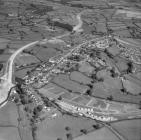Cowbridge & The Duke of Wellington
Items in this story:
The ruins of St. Quentin's castle in Llanblethian show evident proof that Cowbridge was a settlement during the Roman period. After that there is no sign of activity until the 13th century.
The town received its first charter in 1254 from Richard de Clare, the Earl of Gloucester and Lord of Glamorgan.
By 1307, it had 276 households or dwelling places but by 1349 the Black Death had almost halved this.
Inventory records show that buildings ranging in date from the Middle Ages to the 18th century include the Duke of Wellington, the Bear Inn and the Mason Arms. All these dwellings have substantial medieval fabric.
During the period 1440 to 1664, probate records show Cowbridge to be a typical market town. By 1700, Cowbridge alone, of all the Glamorgan towns, ranked as a centre of fashionable life.
Inn-keeping was one of the main trades in the High Street, made lucrative by the town's position as a through-way to West Wales and then to Southern Ireland.
The Duke of Wellington was a coaching inn and dated from the 17th century. Originally, the Black Horse, its name-change occurred when the Iron Duke, himself, stayed overnight in the building on a journey to visit General Picton in Carmarthen.
The well in the lounge has Roman origins and is still functionable. The font, however, is artificial and was designed by art students from Swansea University.
Sources: Cowbridge, Robinson; The Matter of Wales, by Jan Morris; and South Wales Western Mail & Echo.

